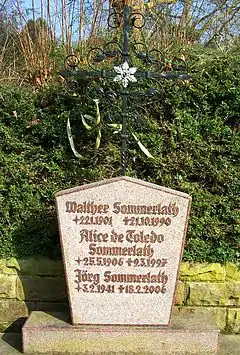Walther Sommerlath
Carl August Walther Sommerlath (22 January 1901 – 21 October 1990) was a German businessman and the father of Queen Silvia, consort of King Carl XVI Gustaf of Sweden. He was president of the Brazilian subsidiary of the Swedish steel-parts manufacturer Uddeholm Tooling after World War II.
Walther Sommerlath | |
|---|---|
| Born | Carl August Walther Sommerlath 22 January 1901 |
| Died | 21 October 1990 (aged 89) |
| Spouse(s) | Alice Soares de Toledo |
| Children | Ralf Sommerlath Walther Ludwig Sommerlath Hans Jörg Sommerlath Silvia, Queen of Sweden |

Early life
He was born and raised in Heidelberg, Grand Duchy of Baden, German Empire (now Baden-Württemberg, Germany). His parents were Louis Carl Moritz Sommerlath (1860–1930), who was born in Chicago, in the United States, and his wife Erna Sophie Christine Waldau (1864–1944). In the mid-1920s, Walther Sommerlath moved to São Paulo, Brazil where he worked for the steel company Acus Roechling Boulerus do Brasil, a subsidiary in the German steel group Roechling.
Marriage
On 10 December 1925, Sommerlath married the Brazilian Alice Soares de Toledo (1906–1997), in Santa Cecília, São Paulo. She was the daughter of Arthur Floriano de Toledo and his wife Elisa de Novaes Soares. The couple had four children:
- Ralf Sommerlath (born 26 November 1929)
- Walther Ludwig Sommerlath (1934–2020)
- Hans Jörg Sommerlath (1941–2006)
- Silvia Renate Sommerlath (born 23 December 1943), married in 1976 to Carl XVI Gustaf of Sweden
Life in Germany
In 1938, Walther Sommerlath left Brazil and returned to Heidelberg. In 1939 he moved to the German capital Berlin. Between 1939 and 1943, Sommerlath ran a company in Berlin that was seized from its Jewish owners by the Nazis. The company manufactured arms to be used in World War II. In 1943, Sommerlath’s plant was destroyed by allied bombs. Later that year, the Sommerlath family returned to Heidelberg.
After the war, in 1947 the Sommerlath family returned to Brazil, where Walther Sommerlath worked as the president of the Brazilian subsidiary of the Swedish steel-parts manufacturer Uddeholm. The family finally moved back to Heidelberg in 1957. He died in Heidelberg in October 1990.
Membership of the Nazi Party
Not very much is publicly known about Sommerlath's Nazi affiliations. Living as a German citizen in São Paulo, Brazil, Sommerlath joined as an expatriate member the German National Socialist Worker's Party, NSDAP/AO, on 1 December 1934, as member no. 3592030. His brother Paul Sommerlath had joined the Party in 1933. Most Germans in Brazil chose not to be members in the party. This is why Brazil's president, Getúlio Vargas, found no real opposition when he decided to outlaw it (1938). The Sommerlath brothers remained members of the Nazi party until the party was banned and dissolved by the allies in 1945.
In 1976, when Silvia was to marry King Carl XVI Gustaf of Sweden, the Swedish daily Expressen interviewed Sommerlath about his Nazi background. In the interview, Sommerlath denied that he had any connections with the Nazi Party, saying that his only part of the War was his work at the arms factory in Berlin.
The Swedish Royal Family has declined to give out any information about the Queen's father's role in the war or the name and facts about his company. But on 16 May 2011, Queen Silvia announced that she would probe her father's alleged Nazi ties in reaction to a Swedish TV news magazine.[1]
In 2020 a group of researchers came forth with newly discovered, diaries and notes that indicate Walther Sommerlath had a hand in organizing the rescue of German anti-Hitler resistance members and Jewish people during the war. After Claus von Stauffenberg had failed in his attempt to assassinate Hitler on July 20 1944, 15 of the resistance members along a number of Jewish people were smuggled to Sweden by train. Walther Sommerlath's name is in the documents originally held by German resistance member Otto Wegner. The train left some hundred kilometers southeast from Berlin containing furniture, and when it arrived in Berlin the furniture were removed and the people loaded along with some concrete pillars to make up for the weight difference. The train got to Trelleborg in southern Sweden safely. Swedish diplomats, members of the Swedish church in Berlin and a few Germans are said to have been involved in the planning.[2][3]
References
- "Swedish queen to probe father's alleged Nazi ties". The Telegraph. Associated Press. May 16, 2011. Retrieved 16 May 2011.
- Petersson, Claes (23 February 2020). "Dokumenten: Silvias far smugglade motståndsmän". Expressen. Retrieved 2 July 2020.
- Tapiola, Paula (24 February 2020). "Kuningatar Silvian isän natsimenneisyydestä uusia tietoja – auttoi salakuljettamaan vastarintamiehiä ulos natsi-Saksasta, vaikka oli natsipuolueen jäsen". Yle. Retrieved 2 July 2020.
External links
- Rosvall, Ted, Bernadotteättlingar, Falköping: Rosvall Royal Books, 1992, ISBN 91-630-1299-5
- Ancestry of Queen Silvia of Sweden
- Queen Silvia's father saved Jews from Nazism